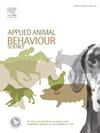不受欢迎的猫在家里抓挠:重新审视它与压力和标记的关系
IF 2.2
2区 农林科学
Q1 AGRICULTURE, DAIRY & ANIMAL SCIENCE
引用次数: 0
摘要
宠物猫(Felis catus)在家中不受欢迎的环境抓挠被归因于某种形式的压力相关标记。然而,抓挠和潜在压力源之间的关系并没有得到很好的证实。情绪反应是理解压力本质的关键,因为它们具有组织功能,有助于动物为与特定目标相关的行动做好准备(例如,挫折使动物为处理其自主性的限制做好准备)。因此,反应和情绪刺激之间的关系可以用来帮助阐明一种行为可能(或可能没有)与压力有关。因此,我们使用了一项调查来探索抓挠发生的物理和社会环境背景,以评估猫抓挠与潜在压力之间的关系。一项针对1797名猫主人的英语在线调查探讨了家中7种可能对猫有重要功能意义的地点,如休息地点、喂食地点和核心领地的物理边界。使用二元逻辑回归对猫频繁与不频繁抓挠的生物学因素(年龄、性别)和潜在压力源(如其他猫、狗、孩子和最近的家庭变化)的存在进行建模。猫最常在休息的地方、客厅和卧室抓人。最常被提及的与抓挠密切相关的活动是积极地与人打招呼、睡觉、进入或离开房间。已知的尿标记预测因子并不能显著预测抓挠。唯一与抓挠显著相关的潜在压力源是家里没有狗(这与压力相关的预测相反),以及一个人在过去3个月内离开了家(这与压力的关系不明确)。抓挠与舒适、睡眠和与照顾者的积极互动相关的位置之间的联系,使我们认为抓挠的主要情感联系涉及积极影响。我们认为,这种类型的抓挠可能会被抑制,而不是被压力源加剧。因此,我们建议,流行的临床行为断言,增加抓挠是家庭压力的标志,需要仔细考虑,而不是假设一定是这样。需要进一步的研究来探索是否存在特定形式的抓挠,这些抓挠显然与某种形式的应激反应有关。本文章由计算机程序翻译,如有差异,请以英文原文为准。
Unwanted feline scratching in the home: A re-examination of its relationship with stress and marking
Unwelcome environmental scratching in the home by pet cats (Felis catus) has been attributed to some form of stress-related marking. However, the relationship between scratching and potential stressors is not well-established. Emotional responses are key to understanding the nature of stress, as they have an organisational function that helps to prepare the animal for actions associated with a specific goal (e.g. frustration prepares an animal for dealing with limits to its autonomy). Thus the relationship between responses and emotionally competent stimuli can be used to help elucidate in what way a behaviour might (or might not) be related to stress. We therefore used a survey to explore the physical and social environmental contexts in which scratching occurs, to evaluate the relationship between scratching and potential stress in cats. An English-language, online survey of 1797 cat-owners explored scratching at 7 types of location in the home which may be of functional significance to the cat e.g. resting places, feeding places, and physical boundaries to the core territory. Binary logistic regression was used to model frequent versus infrequent scratching on feline biological factors (age, sex) and the presence of potential stressors e.g. other cats, dogs, children, and recent household changes. Cats scratched most frequently at resting places and in the living room and bedroom. The most frequently cited activities undertaken in the immediate vicinity of scratching were greeting people positively, sleeping, and entering or leaving a room. Known predictors of urine-marking were not significant predictors of scratching. The only potential stressors significantly associated with scratching were the absence of dogs in the home (which was contrary to the stress-association prediction), and the departure of a person from the household within the last 3 months (which is ambiguous in its relationship with stress). The association between scratching and locations associated with comfort, sleep, and positive interactions with caregivers, lead us to suggest that a major emotional association with scratching involves positive affect. We argue that this type of scratching might be predicted to be inhibited rather than exacerbated by stressors. We therefore suggest that the popular clinical behaviour assertion that increased scratching is a sign of stress in the home needs to be carefully considered and not assumed to be necessarily the case. Further research is required to explore whether specific forms of scratching might exist which are clearly related to some form of stress response.
求助全文
通过发布文献求助,成功后即可免费获取论文全文。
去求助
来源期刊

Applied Animal Behaviour Science
农林科学-行为科学
CiteScore
4.40
自引率
21.70%
发文量
191
审稿时长
18.1 weeks
期刊介绍:
This journal publishes relevant information on the behaviour of domesticated and utilized animals.
Topics covered include:
-Behaviour of farm, zoo and laboratory animals in relation to animal management and welfare
-Behaviour of companion animals in relation to behavioural problems, for example, in relation to the training of dogs for different purposes, in relation to behavioural problems
-Studies of the behaviour of wild animals when these studies are relevant from an applied perspective, for example in relation to wildlife management, pest management or nature conservation
-Methodological studies within relevant fields
The principal subjects are farm, companion and laboratory animals, including, of course, poultry. The journal also deals with the following animal subjects:
-Those involved in any farming system, e.g. deer, rabbits and fur-bearing animals
-Those in ANY form of confinement, e.g. zoos, safari parks and other forms of display
-Feral animals, and any animal species which impinge on farming operations, e.g. as causes of loss or damage
-Species used for hunting, recreation etc. may also be considered as acceptable subjects in some instances
-Laboratory animals, if the material relates to their behavioural requirements
 求助内容:
求助内容: 应助结果提醒方式:
应助结果提醒方式:


